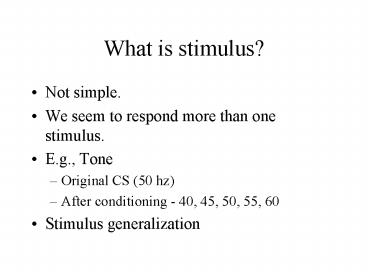What is stimulus - PowerPoint PPT Presentation
1 / 28
Title: What is stimulus
1
What is stimulus?
- Not simple.
- We seem to respond more than one stimulus.
- E.g., Tone
- Original CS (50 hz)
- After conditioning - 40, 45, 50, 55, 60
- Stimulus generalization
2
To restrict the range..
- Use stimulus discrimination training
- E.g., Tone
- CS 50hz
- CS- 60hz
- Animals will not respond to 60hz
3
What does it all mean?
- We dont form single association between a
stimulus and a response. - Conditioning is much more complex than that.
4
And, it gets worse...
- When you use more than one CS.
- Compound stimulus
- What would be the effect of presenting more than
one CS? - Would every CS equally become an effective
signal? - Yes and no.
5
Overshadowing Kamin (1969)
- Acquisition Phase
- CS (light) Loud Noise (80db) - UCS
- CS (light) Not-so-loud Noise (50db) - UCS
- Test
- Light
- Loud Noise (80db)
- Not-so-loud Noise (50db)
6
Which elicited response?
- Light - CR
- Loud Noise - much less
- Not-so-loud Noise - much much much less
- But, all these were paired with UCS.
- Why didnt they become equally effective?
- Kamin - Salient CS prevents others from forming
association.
7
Blocking
- Phase I
- CS1 - UCS
- Phase II
- CS1 CS2 - UCS
- Phase III
- CS1 - CR
- CS2 - No CR
8
Configural cue
- We dont always form separate association with
individual elements. - We sometimes form association with the stimulus
as a whole. - AB - UCS and CD - UCS
- If we formed separate association with each
element, then..
9
- AD - CR
- BC - CR
- But, if association is based on stimulus as a
whole - AD - no CR
- BC - no CR
- So, conditioning is more complicated than you
might think.
10
What is response?
- Pavlov
- CR is the same as UCR
- Stimulus substitution - CS is substituting UCS
- That is not the case.
11
Siegel et al
- Used morphine as UCS.
- Acquisition
- CS - UCS (morphine) - UCR (analgesia)
- Test
- CS - ????
- Stimulus substitution - analgesia
- But, they found - hypoanalgesia
12
But, CR is not always the opposite of UCR.
- Siegel et al
- Acquisition
- CS - UCS (mega insulin) - UCR (convulsion)
- Test
- CS - CR (convulsion)
13
Why?
- Some activates opponent process
- Two phase responses
- Phase I - analgesia
- Phase II - increase sensitivity to compensate
- Sometimes CS forms association with Phase II
response. - Wagner - SOP sometime opponent process theory
14
- Basis of drug addiction.
- We become more and more resistant as CS activate
more and more opponent responses. - E.g.,
- CS (taste) - UCS (alcohol) - UCR (depressed nerve
activities) - CS (taste) - CR (increased nerve activities)
- Need to drink more and more to feel the alcohol
15
So
- We know stimulus is more complicated than it
seems. - We know response is more complicated than it
seems. - And, when a CS is paired with a UCS, the CS
starts to elicit a response. - But, why?
- Two theories
16
Pavlov
- It is based on the law of contiguity.
- An association is formed when two elements are
presented together in a contiguous fashion.
(Brown, 1882) - Obviously CS-UCS pair satisfies this condition.
17
But,
- A contiguous presentation of CS and UCS does not
always produce association. - Rescorla
- CS - UCS
- CS - UCS UCS
- CS - UCS CS
- As CS and UCS are presented between trials, the
situation becomes less predictable.
18
Found
- Conditioning is more effective when the situation
is more predictable. - Contiguity alone is not enough to produce
association. - Pavlov was wrong.
19
Wagner and Rescorla Contingency theory
- Two assumptions
- An association is formed to the extent that a CS
signals the occurrence or non-occurrence of a UCS
(contingency). - An association is formed to the extent that the
occurrence or non-occurrence of a UCS is
surprising (surprisingness).
20
Math Formula
- ?V ? (? - V)
- ? Maximum associative strength a given UCS can
support - V Current strength
- ? Rate of learning
- ?V Change in associative strength after a trial.
21
How does it work?
- ? 100, ? .20
- Acquisition curve
22
When you stop presenting UCS
- ? 0, ? .20
- Extinction curve
23
Supportive evidence
- Blocking
- ? 100, ? .60
- Why does CS2 fail to form association?
- What would be the solution?
24
Evidence against
- latent inhibition
- Presentation of CS alone prior to experiment
makes it more difficult to produce conditioning. - Why?
- ? 0, ? .20
25
Application
- Prevention of craving.
- Difficult to quit using drug because anything
that related activates craving response.
26
So,
- Use classical conditioning to break that
association. - E.g., Smoking
- CS (anything that is related to smoking)
- CR (craving anticipating nicotine)
27
Treatment
- Present CS but not UCS
- Go though the motion of smoking.
- Light up a cigarette (CS)
- But, dont smoke, discard it (no UCS)
- After many repetition, craving will be
extinguished.
28
Other applications
- Counter conditioning for fear response.
- Lowering immune reaction after transplant.
- Etc.

